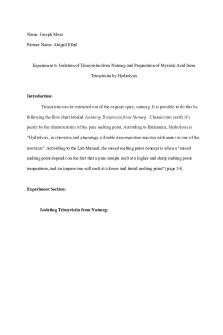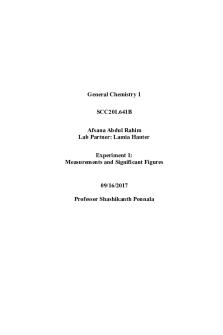Post lab 1 - just a general lab report of org labs including reagents, questions and mechanisms PDF

| Title | Post lab 1 - just a general lab report of org labs including reagents, questions and mechanisms |
|---|---|
| Course | Mod Org Chem Lab I |
| Institution | University of Georgia |
| Pages | 2 |
| File Size | 67 KB |
| File Type | |
| Total Downloads | 8 |
| Total Views | 134 |
Summary
just a general lab report of org labs including reagents, questions and mechanisms...
Description
Moledina 1 Nida Moledina Emily Lab 1 Post-lab 9 September 2014
Results In this experiment the unknown compound’s code was T53Q42. The initial weight of the unknown impure sample was 1.006 g, and the approximate volume of solvent (water) to dissolve the compound was 10.0 mL. The final weight of purified product was 0.236 g. The initial fast/rough melting point of pure compound was 50.0°- 53.0°C. The slow/accurate melting point of pure compound was 50.1°- 52.2°C. The potential unknown identity #1 was Vanillin. The range of the mixing melting point #1 was 77.0°79.0°C. The potential unknown identity #2 was Ethyl 3,5-dinitrobenzoate. The range of the mixing melting point #2 was 48.0°- 49.0°C. The percent recovery is the amount of pure product recovered divided by the amount of crude material all multiplied by 100. The percent recovery in this case is (0.236g/1.006g) x 100 = 23.5%.
Discussion/Conclusion Although the melting point of Vanillin more closely matched that of the unknown, the unknown SHOULD have been Ethyl 3,5-dinitrobenzoate, which actually possesses a melting point range of 93.0°- 95.0°C. The unknown T53Q42 must be Ethyl 3, 5dinitrobenzoate because the two compounds’ melting points are very similar. Furthermore, both compounds also look similar with their flakey texture. The 50:50
Moledina 2 mixture technique further should have proven this conclusion because the unknown and Ethyl 3,5-dinitrobenzoate mixture’s melting point should have been very close to the melting point of Ethyl 3,5-dinitrobenzoate. Unfortunately, the expected results were not achieved as the impurities were not completely filtered from the initial unknown solid. Therefore, the unknown ended up acting as an impurity in both 50:50 mixtures. However, if the initial solution was filtered further, perhaps for at least 10 more minutes, the results may have been more accurate. Time did not allow for a second trial or a prolonged filtration process to occur. A 23.5% recovery proves that the filtration process was not completely carried out, as a higher mass of pure product recovered skewed the results....
Similar Free PDFs

Post Lab - lab report
- 2 Pages

Post lab - Post Lab 1
- 2 Pages

Post Lab Report Lab 5
- 5 Pages

Post Lab Report 7
- 8 Pages

Post Lab Report 10
- 8 Pages

Post lab report 4
- 12 Pages

General Chemistry Lab Report 1
- 10 Pages

Lab questions - lab report
- 2 Pages

POST LAB 1 - Grade: A
- 2 Pages

Post Lab Questions - answers
- 3 Pages

General unknown lab report
- 2 Pages
Popular Institutions
- Tinajero National High School - Annex
- Politeknik Caltex Riau
- Yokohama City University
- SGT University
- University of Al-Qadisiyah
- Divine Word College of Vigan
- Techniek College Rotterdam
- Universidade de Santiago
- Universiti Teknologi MARA Cawangan Johor Kampus Pasir Gudang
- Poltekkes Kemenkes Yogyakarta
- Baguio City National High School
- Colegio san marcos
- preparatoria uno
- Centro de Bachillerato Tecnológico Industrial y de Servicios No. 107
- Dalian Maritime University
- Quang Trung Secondary School
- Colegio Tecnológico en Informática
- Corporación Regional de Educación Superior
- Grupo CEDVA
- Dar Al Uloom University
- Centro de Estudios Preuniversitarios de la Universidad Nacional de Ingeniería
- 上智大学
- Aakash International School, Nuna Majara
- San Felipe Neri Catholic School
- Kang Chiao International School - New Taipei City
- Misamis Occidental National High School
- Institución Educativa Escuela Normal Juan Ladrilleros
- Kolehiyo ng Pantukan
- Batanes State College
- Instituto Continental
- Sekolah Menengah Kejuruan Kesehatan Kaltara (Tarakan)
- Colegio de La Inmaculada Concepcion - Cebu




